People who use mobile devices tilt their heads to operate them. This posture causes text neck syndrome — severe strain in the neck and shoulders. Once muscles adapt to these positions, they pull the entire spine out of alignment. If left unchecked, this leads to stiffness, pain, and serious musculoskeletal disorders.

An adult human head weighs around 10-12 pounds. Most people crane their necks forward by 45° when using mobile devices. This places 50-60 pounds of force on the neck. That’s five times more than the normal load.
Over a year, the average smartphone user will spend around 1200 hours(1) in this position (3 hours per day). That builds up as severe strain in the spine, cervical ligaments, and surrounding muscles.
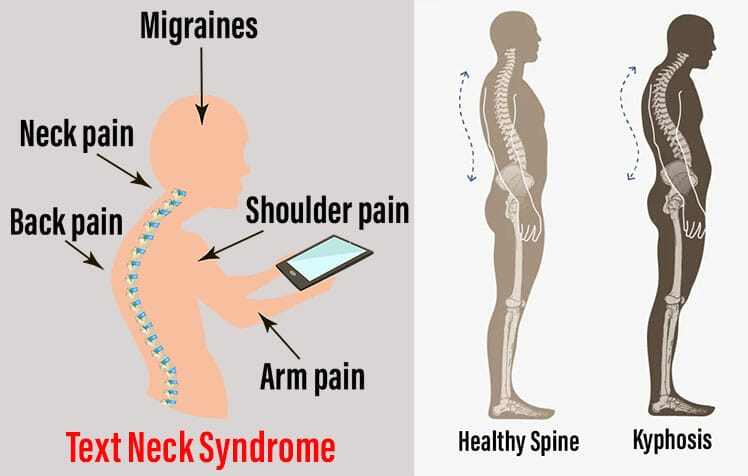
At first, strain manifests as neck and shoulder pains. Stiffness, tingling limbs, and frequent migraines are common symptoms. Over time, these lead to more serious problems. These include:
- Thoracic kyphosis: excessive forward curvature of the upper back. This tightens hamstrings and stiffens the upper back.
- Spinal disc degeneration: slumped postures wear down spinal discs. At first, this limits movement. Once degenerated discs leak fluid, swelling and pain emerge.
- Chronic fatigue: misaligned muscles burn more energy than normal to hold the body up against gravity.
Mobile Use Strains Neck And Shoulders
Mobile computing with a downward head position distorts a healthy cervical spine curvature. To compensate for the misalignment, neck and shoulder muscles must work harder.
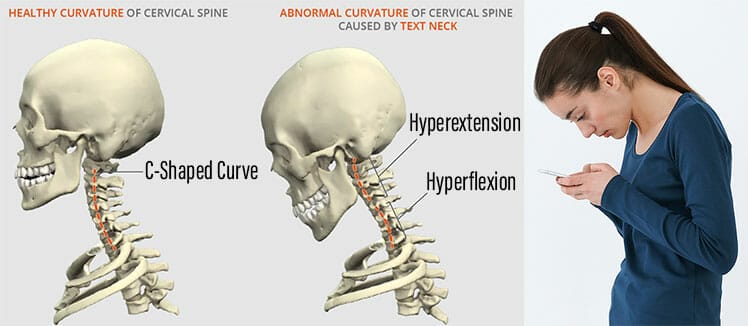
Over time, this stress builds up — until the body breaks down. This will render you immobile, lethargic, and in constant pain. Then, you’ll have no energy (or motivation) to turn things around.
Prevent this from happening to you by educating yourself. This section explains how excessive mobile usage affects both the neck and shoulders.
Mobile User Neck Strain
When using a mobile device, most people tilt their heads forward by 45° or more. This position strains the neck, shoulders, and eventually the spine.
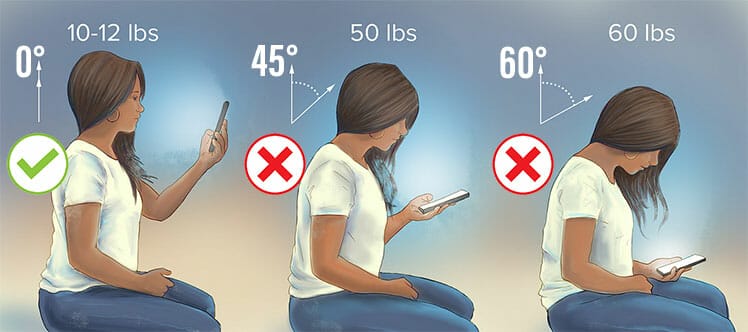
The logical antidote is to balance the head so that it doesn’t tilt in either direction. Specifically, a neck flexion of 0-15° is best for mobile computing(2). This range best reduces muscle activity in the Cervical Erector Spinae (CES) and Upper Trapezius (UT).
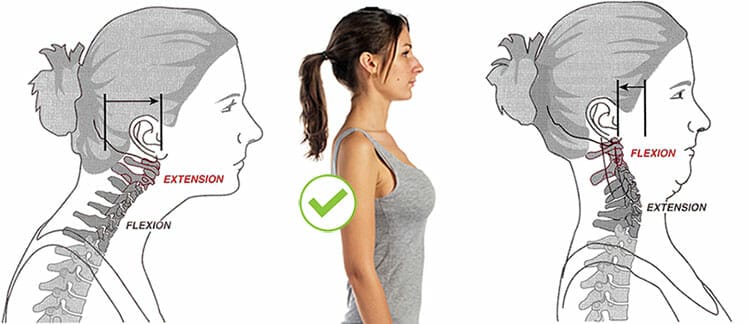
But the perfect neck flexion angle is 0°. A head balanced precisely above the shoulders helps you to maintain crisp neutral postures. In those positions, muscle activity is the lowest — from head-to-toe!
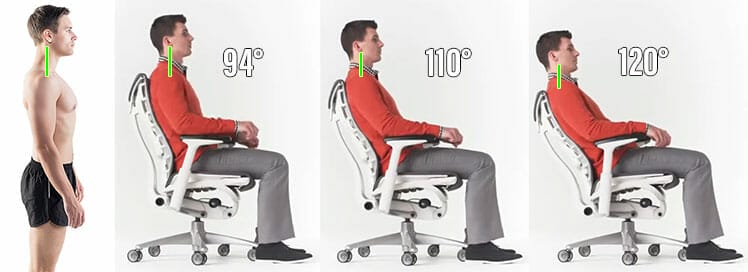
For instance, neutral postures in a Herman Miller Embody chair keep the head in a 0° tilt through all ranges of motion.
Mobile Usage Shoulder Strain
Most mobile ergonomic studies focus on the neck. A recent Khon Kaen University study (3) shed light on shoulder stress caused by mobile computing. 32 students performed texting tasks with a steady 0° neck flexion (head balanced perfectly atop the shoulders).
Then, they alternated among four different shoulder flexion angles: 15°, 30°, 45°, and 60°. Muscle activity was measured in the CES, UT, lower trapezius (LT), and anterior deltoid (AD).
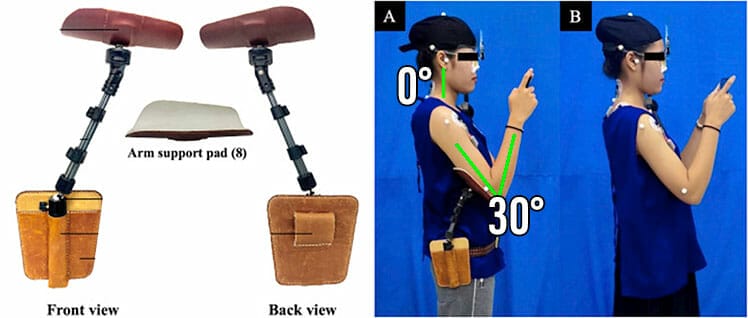
Results showed AD and LT muscle activity increased as shoulder flexion angles did. A 30° shoulder flexion proved the best compromise of activation levels among the four muscles. This angle also induced the lowest neck and shoulder discomfort scores.
Corporations Ignore Text Neck
Throughout ergonomic history, workplace designers have consistently glossed over several genuine human factors. For example, schooling became mandatory for American kids in the 1800s.

Soon after forced full-time sitting emerged, student back problems skyrocketed. Despite this, unhealthy student seating hasn’t evolved in over 200 years! This trend looks to continue with text neck syndrome.

Today, around 6.5 billion people (83.7% of the global population) have smartphone subscriptions(4). Apple generated $180 billion from iPhone sales in 2021. The amount spent researching text neck solutions caused by their products: zero.
Technostress Problems Are Yours Alone!
Humans are not designed to sit all day in sedentary positions. In the computing era, doing so has yielded several forms of technostress. There is physical technostress (like text neck), mental (information overload), and addiction (hooked on notifications).
On the institutional design front, sedentary health risks and text neck problems are both being ignored. The 5th edition Handbook of Human Factors And Ergonomics came out in late 2021. This is the world’s leading reference for institutional workplace design.
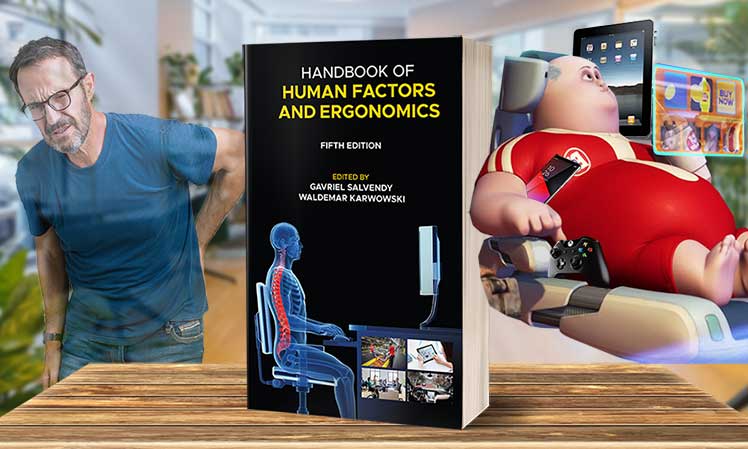
The previous 2012 edition cited office chair back support as a key priority of the time. The 2021 version shifts priorities to focus on multi-device computing support. The new challenge is to figure out ways to get people to spend more time in sedentary, text-neck positions!
However, circa 2022, endemic sedentary lifestyles are one of the greatest health issues of our time. Despite this, in its 1603 pages, the word ‘sedentary’ is only mentioned six times! The phrase ‘text neck’ is not even mentioned once!
This is why megacorporations like Apple earn billions selling phones but ignore the problems they cause. It’s also why the most cutting-edge science for healthy mobile computing comes from places like tiny little Khon Kaen University in Thailand.
Bottom line: business demands excessive texting time but ignores the physical costs. To maintain a healthy posture in mobile-heavy times, the only one you can count on for physical support is yourself!
Text Neck Solutions
Your boss doesn’t care about your craned neck — but will compel you to keep craning it. Text neck syndrome starts out as neck and shoulder pain. Then comes chronic lethargy and a rounding of the upper spine. If you don’t address this, no one will.
A slumped upper back places excess pressure on the spine. 22% of the global population suffers from musculoskeletal disorders.
Predictably, lower back pain is the leading cause of disability in 160 countries(5). Other text-neck-related MSDs:
- Neck pain: the fourth-leading cause of disability in America.
- Shoulder pain: causes around 4.5 million USA doctor visits per year and $3 billion in health costs.
- Chronic fatigue: around 25% of American adults report feeling chronically fatigued(6).
Circa 2022, text neck syndrome can be tackled using three different approaches.
Chiropractic Solutions
A tour through ergonomic history shows that most back doctors have no idea what they’re doing. For instance, when schooling became mandatory for American kids in the 1800s, back problems skyrocketed.
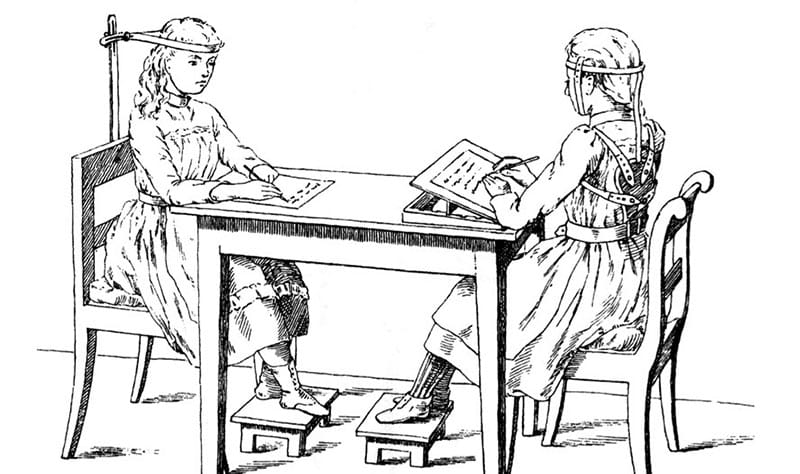
To address those, the doctors of that era literally made up solutions with no theoretical basis. Circa 2022, most chiropractors will address text neck problems with (pricey) back alignment sessions.
These mainly involve massage techniques using pressure points and flexion exercises(7). There are a few problems with this method. First, there’s no way to know for certain that it works. Second, the chiropractic industry has a long history of shady practices based on bunk science.

Third, a 2008 review found that beyond easing back pain, chiropractic manipulation has not been shown to be effective for any medical condition(8).
DIY Mid-Back Chair Posture Rehab
If not keen on chiropractic back alignment, why not align your spine yourself at home? This method uses ergonomic science, muscle memory biomechanics, and a mid-back ergonomic chair.

Any mid-back chair with adjustable arms and adjustable lumbar support will do. That said, the very best chair for the job is the Herman Miller Embody.
Unlike other chairs, the Embody prioritizes support to the thoracic part of the spine. With emphasized upper back support, balancing your head evenly above the shoulders is comfortable and easy.
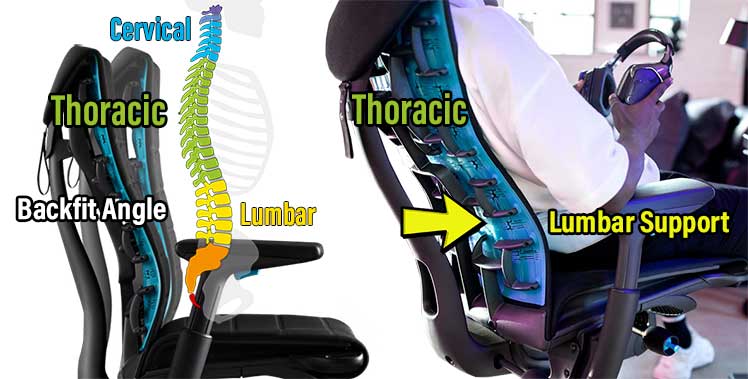
Don’t sweat it if you can’t afford a $1795 Embody. Any mid-back chair with adjustable lumbar support, adjustable arms, and a reclining backrest will do.
Ergonomic Arm Support Prototypes
The preceding Posture Rehab method doesn’t prevent text neck behaviors. Rather, they seek to override the effects caused by text neck syndrome. That’s because ergonomic text neck prevention tools are still in the prototype stage.

The good news is Khon Kaen University’s 2021 research. That gave the world ideal flexion angles for both the neck (0°) and shoulders (30°). Moving forward, this data should help to bring some versions of existing arm support prototypes to market.
Sit-Stand Desk Mobile Support
The above study suggests a 30° shoulder bend while texting to preserve a 0° neck tilt. At present, sit-to-stand desks come the closest to supporting that position.
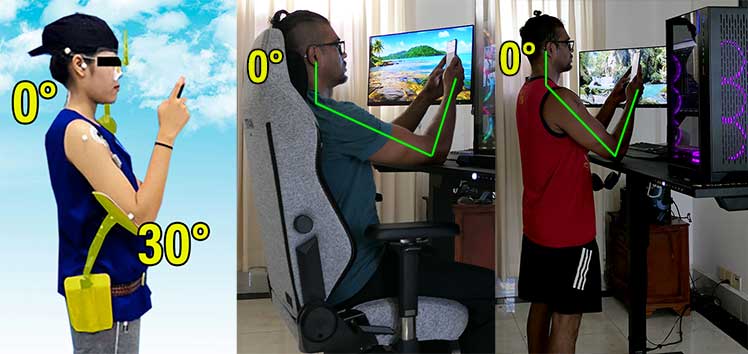
Beyond supporting mobile postures, shifting from seated to standing positions is good for you! The transition resembles a squat. Each squat works the hips, bones, muscles, and joints.
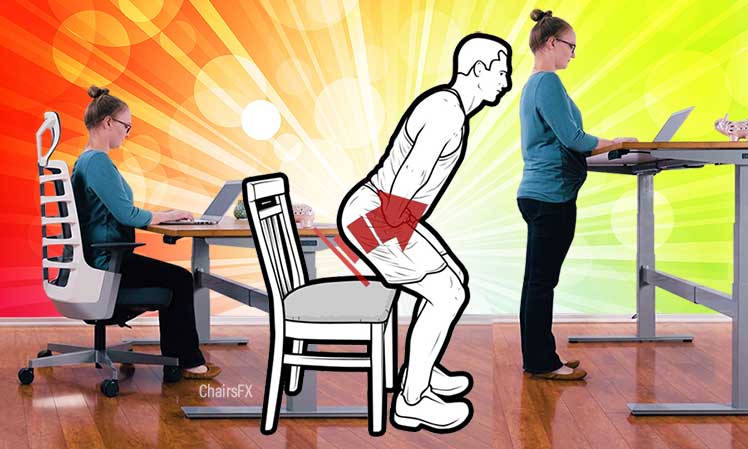
Today, mobile neck support and sedentary computing solutions are huge ergonomic priorities at the institutional level. Given the mobile and movement support that standing desks provide, they’re likely to explode in popularity in the coming years. Learn more:
Conclusion
Here’s the text neck syndrome gist:
- Around 87% of the world (6.5 million people) have mobile phones.
- The average mobile user spends 3 hours daily in texting positions.
- Most users tilt their heads 45° to use their phones. This exerts 50 pounds of extra pressure on the neck and shoulders.
Today, around 22% of the population (1.7 billion) suffer from MSDs. Lower back pain is the leading cause of disability in 160 countries. Neck pain, shoulder pain, and chronic fatigue are endemic.
But here’s a way out. Humans are born with perfect body mechanics. But the body adapts to (and remembers) the positions it holds most often. As life gets in the way, many people forget what healthy body mechanics are!

Luckily, circa 2022, healthy computing mechanics (and methods) are very clear. Studies show that with proper instruction, people can train themselves into healthy positions.

After a short period of disciplined effort, magic happens. First, muscles adapt to healthy positions, thereby relieving themselves of exertion. Then, the fascial system will harden around your new posture and lock it into muscle memory!
So if back pain or text neck is wearing you out, here’s your ticket out. (Simple and intuitive) biomechanical knowledge + an ergonomic chair + a few days of discipline can literally change your life!
Use Muscle Memory To Forge Healthy Ergonomic Habits
Footnotes
- Pablo Robles. ‘Why your smartphone is causing you text neck syndrome’. January 25, 2019. https://multimedia.scmp.com/lifestyle/article/2183329/text-neck/index.html, (accessed 10 April 2022).
- Suwalee Namwongsa, et al. ‘Effect of neck flexion angles on neck muscle activity among smartphone users with and without neck pain’, Ergonomics. 2019 Dec;62(12):1524-1533. DOI: 10.1080/00140139.2019.1661525, (accessed 11 April 2022).
- Weerasak Tapanya, et al. ‘Ergonomic arm support prototype device for smartphone users’, Applied Ergonomics Volume 95, September 2021, 103458. https://www.sciencedirect.com/science/article/abs/pii/S0003687021001058, (accessed 11 April 2022).
- Daniela David, et al. ‘Text Neck Syndrome in Children and Adolescents’. Int J Environ Res Public Health. 2021 Feb; 18. DOI: 10.3390/ijerph18041565, (accessed 11 April 2022).
- ‘Musculoskeletal conditions’. WHO Fact Sheets, 8 February 2021. https://www.who.int/news-room/fact-sheets/detail/musculoskeletal-conditions (accessed 12 March 2022).
- Dr. Stephen Gluckman. ‘Chronic Fatigue Syndrome’, Perelman School of Medicine at The University of Pennsylvania, September 2021. https://www.msdmanuals.com/professional/special-subjects/chronic-fatigue-syndrome/chronic-fatigue-syndrome, (accessed 11 April 2022).
- Dr. Ryan Russell. ‘What Methods Does A Chiropractor Use To Align Your Spine?’ May 7, 2019. https://www.integrativechirocenter.com/uncategorized/what-methods-does-a-chiropractor-use-to-align-your-spine/, (accessed 11 April 2022).
- Wikipedia. ‘Chiropractic controversy and criticism’. Last updated April 2, 2022. https://en.wikipedia.org/wiki/Chiropractic_controversy_and_criticism, (accessed 11 April 2022).




